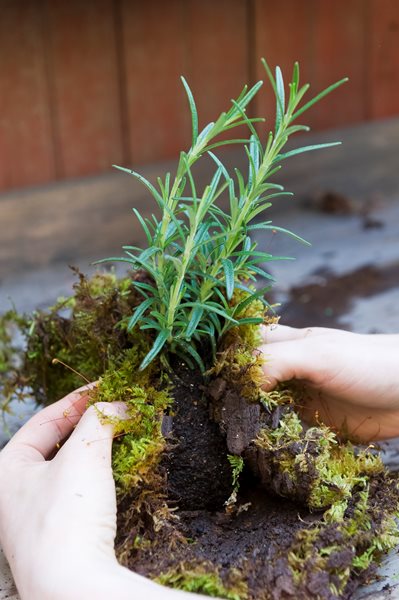Kokedama - Living Containers

Kokedama, also called string gardening, is an inventive spin on hanging plants that requires no container. Instead, roots are packed in a pancake-like mud-clay mixture and then swaddled in moss before the whole unit is bound in twine to be suspended. This display from City Planter in Philadelphia, shows that hanging isn't the only way to go. They also display more grounded versions squatting in saucers.
Maintenance is surprisingly simple. Just dunk the plant in a bucket of water for a minute (or as long as it takes to saturate the soil) once or twice a week, or up to 2 weeks for succulents. Let it drip into a sink or similar receptacle before hanging again. To fertilize, just add soluble fertilizer to its bath once a month.
When you purchase products through links on our site, we may receive an affiliate commission. Thank you for your support.

Step 1
Make the mud pie to wrap the root system by combining 1/3 kokedama medium (a granular, clay-like mineral) with 2/3 peat moss and mix it. Or, you can use a pre-made soil mix.

Step 2
Gradually add water to the mixture to fully moisten it and create a slurry, making sure to mix in the water completely.

Step 3
Choose an appropriate plant with a root ball that's 4 inches across. Remove it from its container and shake off as much soil as possible. Tease apart the roots.

Step 4
Hold the root ball in one hand and slap soil around the roots, squeezing as you go. Rotate the plant until the mud pack covers the roots and holds them firm. It should resemble a softball.

Step 5
Using live sheet moss, cut a piece large enough to serve as a coat that completely wraps the muddied root ball. Wrap it snugly, overlapping and gathering the sheet moss on top.

Step 6
Using waxed polyester cord, tie a girdle to hold the sheet moss in place. Continue circling the sheet moss until the cord holds the moss securely. Tie the end and then attach a hanging cord.

Coleus (Solenostemon scutellarioides) hanging kokedama.

Variegated English ivy (Hedera helix 'Gold Child') kokedama.

Desert rose (Adenium obesum) kokedama in a saucer.




